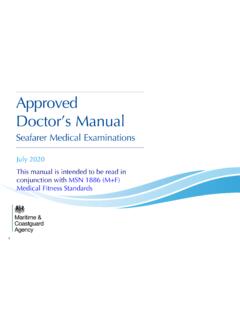Transcription of Wireless Security Standards - United States Army
1 UNCLASSIFIED Department of the army Pamphlet 25 2 9 Information Management: army Cybersecurity Wireless Security Standards Headquarters Department of the army Washington, DC 8 April 2019 SUMMARY DA PAM 25 2 9 Wireless Security Standards This new Department of the army pamphlet, dated 8 April 2019 o Provides guidance for the vetting, approval, acquisition, and use of Wireless technology and Wireless -enabled tools wi thin the Department of the army (throughout). o Contains amplifying procedures and guidance to DODI and the army use of the Department of Defense Unified Capabilities Approved Products List (throughout).
2 DA PAM 25 2 9 8 April 2019 UNCLASSIFIED i Headquarters Department of the army Washington, DC Department of the army Pamphlet 25 2 9 8 April 2019 Information Management : army Cybersecurity Wireless Security Standards History. This is a new Department of the army pamphlet. Summary. This pamphlet provides guid-ance for the vetting, approval, acquisition and use of Wireless technologies within the Department of the army . It supports AR 25 2 and the army Cybersecurity program. This pamphlet provides amplifying proce-dures and guidance to DODI Applicability.
3 This pamphlet applies to the Regular army , the army National Guard/ army National Guard of the United States , the army Reserve, unless oth-erwise stated. Proponent and exception authority. The proponent for this pamphlet is the Chief Information Officer/G 6. The propo-nent has the authority to approve exceptions or waivers to this pamphlet that are con-sistent with controlling law and regulations. The proponent may delegate this approval authority, in writing, to a division chief within the proponent agency or its direct re-porting unit or field operating agency, in the grade of colonel or the civilian equivalent.
4 Activities may request a waiver to this pam-phlet by providing justification that in-cludes a full analysis of the expected bene-fits and must include formal review by the activity s senior legal officer. All waiver re-quests will be endorsed by the commander or senior leader of the requesting activity and forwarded through their higher head-quarters to the policy proponent. Refer to AR 25 30 for specific guidance. Suggested improvements. Users are invited to send comments and suggested improvements on DA Form 2028 (Recom-mended Changes to Publications and Blank Forms) directly to the Office of the Chief Information Officer/G 6 (SAIS PRG), 107 army Pentagon, Washington, DC 20310 0107 Distribution.
5 This regulation is available electronic media only and is intended for the Regular army , the army National Guard/ army National Guard of the United States , and the army Reserve. Contents (Listed by paragraph and page number) Chapter 1 Introduction, page 1 Purpose 1 1, page 1 References and forms 1 2, page 1 Explanation of abbreviations and terms 1 3, page 1 Applicability 1 4, page 1 Department of Defense Unified Capabilities Approved Products List process 1 5, page 1 Chapter 2 Wireless Security Standards , page 1 Administrative requirements 2 1, page 1 Wireless local area network requirements 2 2, page 2 Component configuration requirements 2 3, page 2 Authentication 2 4, page 2 Protection of national Security information 2 5.
6 Page 2 Encryption 2 6, page 2 Bridging, multi-point, and point-to -point technologies and topologies 2 7, page 3 Wireless personal area networks 2 8, page 3 Remote access 2 9, page 3 Chapter 3 Wireless devices, page 3 Contents Continued ii DA PAM 25 2 9 8 April 2019 Wireless portable electronic device requirements 3 1, page 3 Cordless phone 3 2, page 4 Wireless keyboards and mice 3 3, page 4 Bluetooth 3 4, page 5 Wearable fitness devices 3 5, page 5 Chapter 4 Training, page 5 Portable electronic device page 5 Chapter 5 Products, page 6 Wireless devices 5 1, page 6 Approved and procured products 5 2, page 6 Appendixes A.
7 References, page 7 Glossary DA PAM 25 2 9 8 April 2019 1 Chapter 1 Introduction 1 1. Purpose This pamphlet provides guidance for the vetting, approval, acquisition, and use of Wireless technology within the Depart-ment or the army (DA), and leverages applicable Department of Defense (DOD) and DA publications. It amplifies pro-cedures and provides guidance to DODI and the army use of the DOD Unified Capabilities (UC) Approved Products List (APL). This pamphlet also addresses the process for acquiring Wireless technology tools on the DOD UC APL, and explains the roles and duties within the DOD UC APL process.
8 The DOD UC APL process provides for an increased level of confidence through cybersecurity and interoperability certification. 1 2. References and forms See appendix A. 1 3. Explanation of abbreviations and terms See the glossary. 1 4. Applicability This publication applies to all army -owned, controlled, or contracted Wireless networks, systems, and devices that process, store, or transmit unclassified information. This pamphlet does not apply to the vetting processes of open source technol-ogies, cross domain solutions, protected distributed systems, and communications Security technologies requiring National Security Agency (NSA)-approved key management (such as suite A and suite B).
9 1 5. Department of Defense Unified Capabilities Approved Products List process a. The DOD UC APL was established in accordance with the DOD Unified Capabilities Requirements (UCR). The DOD UC APL process was developed in accordance with DODI and is managed by the Defense Information Systems Agency (DISA) Network Services Unified Capabilities Certification Office. Use of the DOD UC APL allows DOD components to purchase and operate UC systems over all DOD network infrastructures (see DODI ). b. According to AR 25 2, the army will use the DOD UC APL when purchasing all cybersecurity or cybersecurity-enabled hardware, firmware, and software components (excluding cryptographic modules).
10 Chapter 2 Wireless Security Standards 2 1. Administrative requirements a. Authorizing official. The authorizing official (AO), appointed in accordance with AR 25 2, is responsible for en-suring that all Wireless local area network (WLAN) and portable electronic device (PED) technologies (for example, smartphones, tablets) adhere at a minimum to the requirements outlined in AR 25 2 and this DA PAM. For non-compliant Wireless implementations, the AO is responsible for approving and maintaining mitigation plans as part of their acceptable level of risk determination.














